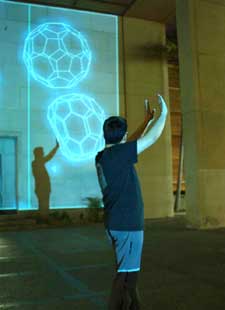|
Interacting with virtual molecules that respond to
shadow is one of the projects blending art and science. |
|||
|
BY CYNTHIA LEE Helping the public to access the bewildering nanoworld and, at the same time, exploring the impact of this emerging science on culture, Victoria Vesna, chair of the Department of Design | Media Arts, and chemist Jim Gimzewski have collaborated on projects that merge art, science and technology. Recently, the two unveiled to the campus the core of their collaboration, “Zero@wavefunction: nano dreams and nightmares,” which premiered at the Biennial of Electronic Arts in Perth, Australia, last August. To make the invisible nanoworld visible in a metaphorical way, Vesna and Gimzewski created Buckyball Shadows, a playful projection of glowing, computer-generated buckyballs, which appeared giant-sized projected on the side of Young Hall during a demonstration Jan. 29. The virtual balls respond to shadow via sensors. Casting giant shadows against the wall, people reached out to “touch” the balls which contract and move just as one can imagine molecules might when manipulated by a nanoscientist using a scanning tunneling microscope. This key instrument, with its probe made of a single atom, allows nanoscientists to perceive the presence of atoms, not by sight, but by touch, explained Gimzewski, a nanoscientist for nearly three decades. “Fingertips replace eyes in the nanoworld,” he explained. Participants who interact with these virtual molecules may experience on an emotional level how he connects with the molecules he works with in his mind, he explained. “I hope these projects will give people a sense of the wonderment and interactivity we experience in science.” Gimzewski and Vesna began collaborating after meeting in 2001 at a UCLA conference, “From Networks to Nanosystems,” co-organized by Vesna. “He was very enthusiastic, and also very
understandable,” said Vesna. “A lot of times, science can be
off-putting. You feel you need a translator. But Jim is very visual;
the visuals he provided gave me a way to experience some of the
ideas he was talking about.” There were other parallels: Both work in emerging disciplines that are constantly being redefined. And both fields cross traditional academic boundaries and encourage non-traditional linkages. While Gimzewski has always been interested in art and culture, Vesna has experimented extensively with areas that might fall within the chemist’s realm: tensile systems and shapes such as the tetrahelix, hexagon and the buckyball, a ball-shaped carbon molecule, reminiscent of a geodesic dome. “What we are trying to do is not only make nanotechnology more accessible to people, but also to pose a lot of questions about how this impacts our culture,” said Vesna. “Shadows” and several other interactive seed projects, which can be seen at http://notime.arts.ucla.edu/zerowave, will be expanded in “Future Echoes,” a 10,000-square-foot exhibition to open Nov. 23 at LACMALab. Joining them is Katherine Hayles, professor of English and Design | Media Arts and a leading scholar in electronic literature. Graduate students from all three areas are involved in the project. The three faculty members are part of the Center for Social Interfaces and Networks Advanced Programmable Simulations and Environments, which promotes “a culture of digital adventure” through collaboration and experimentation. |
|||
|
|
Copyright 2003 UC Regents
Questions / Problems? | [HOME]
